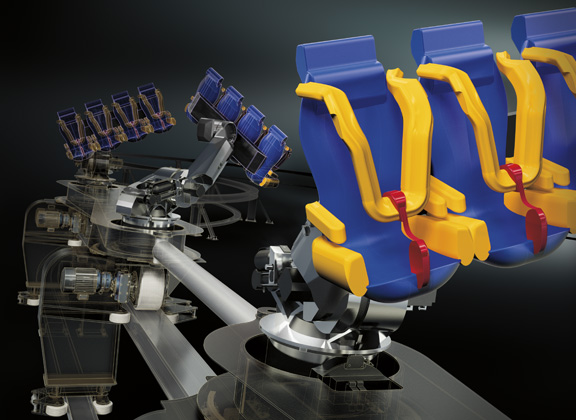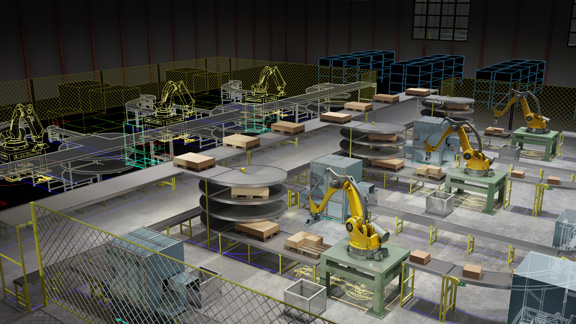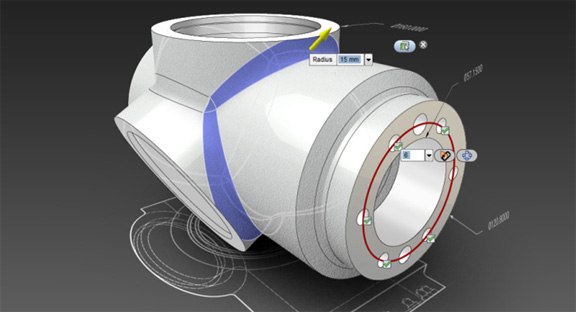Latest News
April 5, 2011



Perhaps you’re primarily an AutoCAD user, wondering if you should tinker with Autodesk SketchBook Designer to add some flair to your DWGs. Perhaps you’re a mechanical designer using Autodesk Inventor, thinking about wowing your clients with some renderings and animations created in Autodesk 3ds Max. If so, you may like Autodesk’s latest sales approach for its 2012 portfolio.
This March, Autodesk introduced a series of suites—bundles of software selected with specific workflows in mind. To list each bundle with its breakdown, along with different editions available, will stretch this blog post beyond what’s acceptable. So you can go check out each bundle at Autodesk’s designated mini-site.
- Autodesk Design Suite, centered around AutoCAD.
- Autodesk Product Design Suite, centered around Inventor.
- Autodesk Building Design Suite, centered around Revit.
- Autodesk Entertainment Design Suite, centered around 3ds Max.
- Autodesk Factory Design Suite, centered around enhanced AutoCAD and Inventor.
- Autodesk Plant Design Suite, centered around AutoCAD Plant 3D.
Premium and Ultimate Max
Autodesk’s latest bundle pricing appears to offer more bangs for your bucks (or more code for your cash). The Premium Edition Design Suite, for example, includes AutoCAD ($3,995), Autodesk SketchBook Designer ($495), Autodesk Showcase ($995), Autodesk Mudbox ($745), and Autodesk 3ds Max Design ($3,495). Bought separately, these products would cost more than $9,700. Bundle pricing is $4,995.
Similarly, the Premium Edition Product Design Suite includes Autodesk Inventor ($5,295), Autodesk 3ds Max Design ($3,495), AutoCAD Mechanical ($4,495), Autodesk Showcase ($995), Autodesk SketchBook Designer ($495), Autodesk Vault (price unknown), and Autodesk Mudbox ($745)—a lineup that, if bought separately, would cost you more than $15,000. Bundle pricing is $6,495.
Digging deeper, you’ll probably notice a few common characteristics. At Premium and Ultimate levels, Autodesk 3ds Max is included as the de facto visualization software. Though not apparent in the published breakdown of the suites, you’ll find that Autodesk Inventor Fusion’s editing methods have gradually found their ways into the bundles’ geometry-editing tools.
Reclaiming Lost Grounds with SketchBook Designer
The role of SketchBook Designer seems to be to counter the encroachment of vector-raster drawing-editing programs. Not satisfied with line drawings produced in AutoCAD, some users resort to Adobe Illustrator, Adobe Photoshop, ACDSee’s Canvas, Corell Draw and others packages to give their lines and arcs artistic treatment. With tools to create and edit stylized Splines and apply gradients and colors, SketchBook Designer may reclaim grounds lost to these graphics packages. Furthermore, concept drawings created in SketchBook Designer’s Splines will be easier to manage in other Autodesk packages like Autodesk Alias, laying the groundwork for complex surfaces.
Factory-Ville on Cloud Nine
Many of these suites contain workflow-specific features not available to those who purchase the listed titles separately. The Factory Design Suite, for instances, offers standard factory components (such as conveyor belts and containers) you can drag and drop into your 2D layouts. The items are preconfigured to snap to existing factory elements, so designing a production facility could be as simple as arranging digital LEGO blocks on a floor plan.
A set amount of these factory components get installed to your Autodesk content library, but the rest lives in the cloud, a remote server accessible online. They’re downloaded to your local drive as you begin selecting them for use in your plan. This eliminates the need to deliver a bloated content library with the installation files. It also lets Autodesk periodically review, refresh, and add to the downloadable library. In the future, Autodesk may facilitate the exchange of user-created content through a community portal.
Eco Material Advisor
One area where SolidWorks has a head start over Autodesk Inventor is in sustainable design development. The introduction of SolidWorks Sustainability Xpress, first as a plug-in to SolidWorks and later as an integral part of the software, marked SolidWork’s dive into CAD-integrated sustainable design. The simple, straightforward tab gives users the ability to explore a design’s environmental impact (measured in carbon emission, energy use, air pollution, and water pollution) based on choice of material, production method, and supply source destination.
Now, Autodesk is releasing its own sustainability tool, dubbed Eco Material Advisor. The tool is the outcome of Autodesk’s partnership with Granta, which specializes in material data. In its debut version, Eco Material Advisor will first appear in Autodesk’s 2012 portfolio. It’s expected to let you estimate energy use, CO2 footprint, water use, and materials cost based on your 3D design.
Like SolidWorks’ Sustainability tool, Eco Material Advisor will let you compare the environmental impact of different design alternatives (for example, one version in steel, another in PVC, another in cast iron), by using one as the baseline. This approach lets you experiment with different supply chain, manufacturing, and design variables, then pick the greenest option.
Krypton Meter
What used to be a technology preview, Autodesk Krypton, will soon appear in 2012 products as a series of meters, always ticking in the background to keep track of the energy use and cost of your design as you make changes. The feature is expected to become available not just for Autodesk software users but also for SolidWorks and Pro/ENGINEER users.
Unresolved Pricing Questions
According to Hilde Sevens, a director of product management at Autodesk, “Subscription price is not going up, so please put that out of your mind.”
Autodesk press office clarified, “The customers who currently are on a subscription (say, for AutoCAD Inventor Professional) who would be receiving the Product Design Suite instead— for these customers, there is no change in their subscription pricing despite now being on subscription for many more products. The subscription prices for the suites themselves, however, are higher than current subscription prices for standalone products (which is designed to reflect the greater value of subscription across all the products in the suite).”
At present, it’s unclear if subscription customers who receive an automatic upgrade to a suite will subsequently be required to pay a higher subscription fee (to reflect the greater number of software titles they can now access). It’s also unclear if certain titles will remain available for subscription individually, apart from the suite offerings where they appear.
In my view, it’s critical that Autodesk continues to give buyers the option to purchase its most popular titles—AutoCAD, Autodesk Inventor, and 3ds Max, to name but a few—individually. Suite deals sound sweet for those who need additional software, but if those who don’t need it are pressured to gobble it up, the offer could quickly turn sour.
The Sum of All Bundles
For the deep discount you get alone, Autodesk’s suite pricing may indeed strike some as tantalizing. Some bundled titles like SketchBook Designer are consumer-friendly and easy to learn, so you can easily become productive with them in no time. Other titles like Autodesk 3ds Max and Navisworks may require you to invest a fair amount of time and training in them before you can become proficient. Choosing the right bundle, or analyzing your own workflow to decide if it warrants additional titles, may be the best way to safeguard yourself from inadvertently purchasing shelf-ware.
It is worth noting that Autodesk’s 2012 suites are much more than a collection of titles with heavy discount. In addition to what you would normally get from the listed titles, you get workflow-specific interoperability among bundled titles and additional features (a good example is the version of AutoCAD and Inventor included in the Factory Design Suite). So if you’re thinking of investing in a few more complementary tittles to your collection by opting for a bundle, you’ll find that the whole is more than the sum of its parts.
Note: This blog post is updated on April 7 to reflect the pricing information received from Autodesk.
Subscribe to our FREE magazine, FREE email newsletters or both!
Latest News
About the Author
Kenneth Wong is Digital Engineering’s resident blogger and senior editor. Email him at [email protected] or share your thoughts on this article at digitaleng.news/facebook.
Follow DE





